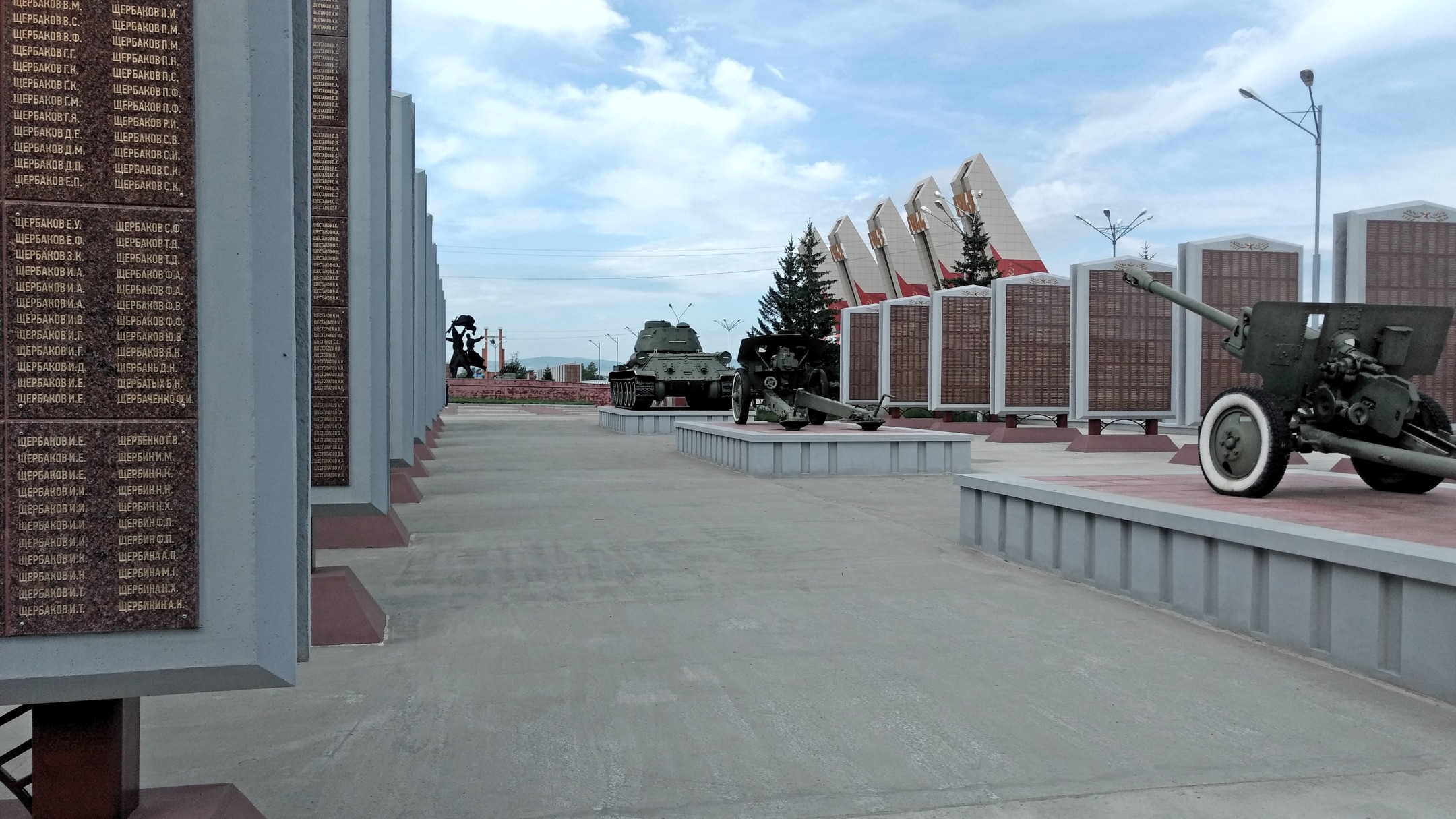My summer in Chita: 11. Visiting the war memorial

The center of the war memorial
In 1997, Tanya Sukhanova came from Chita for summer study in Vermont. We took a trip to Washington, DC, and I asked if there was anything she wanted to be sure to see. She wanted to see Arlington Cemetery. At the time I didn’t understand her compelling interest in what is admittedly our most important war memorial. Over the years, and especially in the last few, I begin to understand.
On July 24th, Victor and Elena Kulakovsky, Olga Fleshler, and I paid a visit to the World War II memorial just outside Chita’s center.
The memorial is very large. Approaching it you first come upon the eternal flame set in a low polished granite platform. Behind that is a large raised blackened bronze sculpture of three soldiers striding forward with a flag upraised. Victor reached up and laid his two carnations at the feet of the three.
Behind this statue and across a plaza are five tall matching columns, perhaps 70 feet high, in a modern (1960s?) style: angular and leaning dramatically forward. Each top is emblazoned with one of the five years of the war, 1941 – 1945. Across the front of the columns is a recently added banner in form of the old black and orange St. George ribbon that in past several years has come to be used to represent Russia alongside the older symbol of the hammer and sickle of Soviet times. At this memorial, both symbols are in evidence. This banner says, “All for the Front, All for Victory,” a reminder for these American eyes, that the Eastern Front of World War II was on Russian soil and that of other republics of the Soviet Union, and the destruction and carnage of the bulk of the Allied fighting of the war was of their own villages and cities and people.

Victor leaves flowers
To the left and right of the central grouping, the plaza extends, each side with panels listing the names of the war dead from Zabaikalye, ~175,000. On these side plazas are various large war machinery on display: tanks, vehicles (the famed Katyusha missile launcher), cannons, naval mines, etc. A recent addition to the two side plazas are permanent markers with photos of medal winners including some words about their service and their deaths. There are also markers with pictures and words for medal winners who survived, some into the 21st century.
Though the Nazis were defeated far away in western Soviet Union and pursued back to Germany for the end of the European war, the war did come east to Zabaikalye when the United States requested the Soviet Army’s help to end the Japanese war in 1945. The Army massed here in Zabaikalye and the neighboring republic of Biribizhan ready to assist, and entered Japanese-held China in the very last few days of the war.

Names of the dead, cannons, and the central statue and columns in the distance
I was reminded of my visit two years ago when I arrived only a couple of weeks after the 70th Anniversary Victory Day celebration, May 9, 2015. Posters and banners were everywhere. There was a gala concert at Philharmonia, and Victor’s son, Vova gave me his ticket so I could attend. Even though I didn’t understand much of the words, it was clear in the stage productions–one was a short play was about letter writing during the war–that this was not only a celebration of the Army, but of the whole nation under siege and coming through victorious, repelling the invaders. It is not a story I recognize from my own understanding of history, so it has taken me a long time to realize how important it is for Russians to remember and celebrate such a tough and sad moment, to honor the sacrifices of their forebears and to hope such a thing never happens again. I have not yet found a friend here who did not lose a family member in the war. Walking among the names and faces on the plaza, my friends were in tears, not only for the ones they saw, but for their own family members who served and lived through those years.
I left my own red carnations at each of the columns. I wanted to honor our great unsung allies (unsung in the United States) in that fight against the imperial designs of both the Germans and the Japanese, a part of my history that I had never known or even cared about until recently. In the open space at the bottom of each column were tablets to read. Olga helped translate. I was surprised at their content at first. No words about the glories of war or of fighting. Only the acknowledgment of helping and sacrifice in the form of matter of fact statements of statistics about the contribution to the war effort by the people, the farms, the factories, and the natural resources of Zabaikalye. For example: how many pounds of meat were provided, how much milk, produce, wool, cattle, how much in money donations given to various campaigns, how much wood and minerals came from the region, and how many people died, and how many received medals.

Translation: “During the war years, the Chita region handed over to the state 15 million poods (a “pood” is approximately 37 lbs) of bread, 3.5 million poods of milk and cheese, hundreds of thousands of poods of wool, and 23,000 horses. And transmitted free of charge and sold at state prices to the state farms of the regions affected by the fascist occupation, 72,810 head of livestock.”



